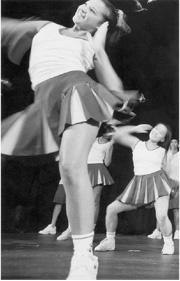FOR MANY OF US, the word “collage” brings back memories of grade school, when arts and crafts meant a bottle of Elmer’s glue, safety scissors, and a stack of construction paper and magazines. Making collages was fun, random, and quick: Paste some pictures here and there, and voil༯I>, it was art.
Laurie Cinotto: Some Facts in Nature (and Other Stories)
SOIL Gallery, ends April 30
Catherine Chalmers: Food Chain: Encounters Between Mates, Predators, and Prey
Center on Contemporary Art, ends May 22
Modern collage artists often approach their work with a similar kind of whimsy, but the results can be far from simplistic. Laurie Cinotto’s latest work, “Some Facts in Nature (and Other Stories),” transforms the SOIL Gallery into a room full of nostalgic tchotchkes and handmade collages bearing images of birds, flowers, and butterflies. The collages, each of which can be held in the palm of one’s hand, are composed of photographs, embroidery, and other odd objects that she’s found and saved over the years. The show could be decorative—except that Cinotto has encased every one of her items in plastic, rendering the sweet images a bit unsettling. Grouped together, they come across as a tightly conceived commentary on our society’s love-hate relationship with nature.
On the floor, Cinotto has laid out cheap pink linoleum tiles, reminiscent of a basement rec room. On top of them stand vintage handbags, a lamp, an afghan, and other domestic items wrapped in cellophane. The handbags, with their beautiful embroidered flowers and birds, most strikingly exemplify how images from nature are pulled and incorporated into fashion and domestic accessories—we find beauty and comfort when nature is packaged as artifice. Cinotto’s installation presents nature filtered and sealed, static and plastic—like the manufactured environment portrayed in The Truman Show.
Cinotto, who works as a florist by day, pushes this theme further. Several vases of real flowers—all sealed in cellophane—stand alongside the handbags. When I attended the exhibit’s opening, the bouquets appeared fresh. Returning a week later, I found them decaying at different rates—the carnations were still hardy, but the tulips and irises had drooped and lost some of their petals. Their wrappings were covered inside with dew, obscuring the view of them. Struggling to stay alive, the bouquets serve as striking contrast to the products that will last till God knows when.
The collages on the wall are displayed in long strips of plastic that look almost like scrolls, telling stories of life and loss. Along with the purely decorative—a flower-patterned crochet square, for example—there are the personal, such as a blurry photo of Cinotto’s boyfriend swimming in a lake, an eye-shaped collage of fabric, paper, and embroidery dedicated to the artist’s deceased uncle (who donated his organs upon his death), and another in remembrance of a friend who took his own life. Such personal tributes echo the troubling message conveyed by the dying bouquets: Momentary images of life are preservable, but life itself runs its inevitable course.
AT THE CENTER ON Contemporary Art, another artist, Catherine Chalmers, meditates on nature from a radically different approach and aesthetic. Chalmers, a New York photographer, captures in magnified detail images of small critters that give most of us the heebie-jeebies—roaches, tarantulas, praying mantises. In monstrously outsized images, the bugs are shown eating and being eaten.
Titled “Food Chain: Encounters Between Mates, Predators, and Prey,” Chalmers’ photographs are an intersection of science and art. Unlike images from a biology textbook, Chalmers places the creatures, which she raises herself in her home, before austere white backgrounds, thereby affecting the formal staging and color composition after the manner of fashion photography. Chalmers develops her photos in C-print, which results in hypersaturated colors. If the viewer were to focus on the hues rather than the subject, Chalmers’ images would come across as fields of vibrant energy.
But of course her work isn’t just about color. Chalmers wants us to look at these creatures and the very methods by which they survive. The series Caterpillars Eating a Tomato (1994) begins with an image of a shiny red tomato, with a head of a green caterpillar poking out from the top. The series of 11 photographs shows the steps by which the tomato is completely consumed. We get a close-up of the caterpillar, then, in a following shot, we see three more caterpillars tearing their way through the tomato’s skin. Another shows them writhing to break down the vegetable, and a later shot shows them scattered on a floor littered with bits and pieces of tomato meat and seeds. Last is a shot of the clean floor, the caterpillars having consumed every bit of the food.
Then, in a shocking follow-up, a praying mantis ingests a caterpillar that’s just eaten the tomato. A 13-image series shows the praying mantis attacking the caterpillar and sucking its innards, as if “squeezing paint out of a tube,” as the artist has described it. You find yourself contemplating how humankind fits into the raw dynamics of the food chain.
Like recent movies such as A Bug’s Life and Antz, Chalmers’ photographs force us to see insects as human-like creatures. One series, Frog Eating a Praying Mantis (1996) is especially successful in this regard. Magnified, frogs show almost cartoonish facial expressions. Chalmers’ frog sits silently behind its prey like a jade Buddha, then opens its mouth wide, darts its tongue, and captures its victim in one graceful swoop. Throughout, the frog appears content, practically smiling. The final shot, which shows the bloated green creature after having swallowed its meal, looks like your uncle after Thanksgiving dinner. You can’t help but feel happy for the frog.






